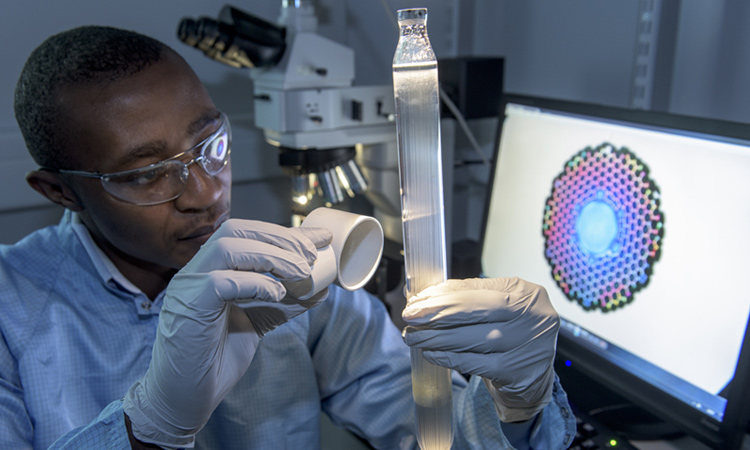 Researcher Eric Numkam Fokoua checks a microstructured fiber preform in the Optoelectronics Research Center at the University of Southampton, U.K. [University of Southampton]
Researcher Eric Numkam Fokoua checks a microstructured fiber preform in the Optoelectronics Research Center at the University of Southampton, U.K. [University of Southampton]
Vacuum is the very best optical material we know, but we need guidance,” OSA Fellow Sir David Payne said, describing the attractions of hollow-core optical fibers in a plenary talk at OFC 2020. Payne’s observation is clever and spot-on. Light travels through vacuum without loss, so humans can observe light from the Big Bang 13.8 billion years ago. Yet that initial light burst has spread ever since in all directions, so only a trickle of photons, red-shifted to the microwave band by cosmic expansion, reaches Earth. The challenge has always been guiding the light where we want it to go.
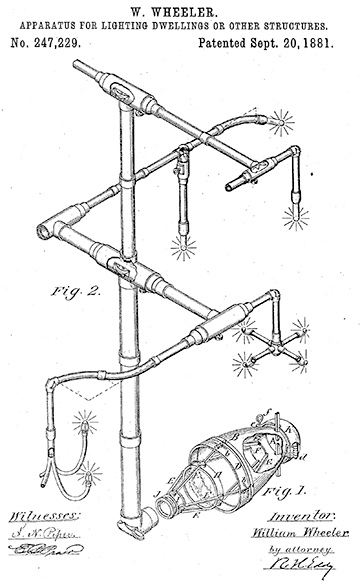 In the late 19th century, William Wheeler patented a system for piping light from basement arc lamps through residential dwellings in hollow tubes. [Enlarge image] [U.S. Patent No. 247,229 (1881)]
In the late 19th century, William Wheeler patented a system for piping light from basement arc lamps through residential dwellings in hollow tubes. [Enlarge image] [U.S. Patent No. 247,229 (1881)]
William Wheeler, a young engineer in Concord, MA, USA, faced the light-guidance challenge when he sought a way to distribute light from central arc-lamp sources inside homes in 1880. Incandescent bulbs were in their infancy, and homes depended on dim light from gas lights, lanterns or candles. Wheeler designed and patented a system of hollow glass pipes that were clear on the inside, but covered on the outside in a reflective silver film, coated with asphalt to prevent tarnishing. He envisioned that the pipes would distribute light from a basement arc lamp to luminaires in each room.
Wheeler left no model with the patent office, and indeed may never have built one. His idea was ingenious but impractical, because metal surfaces absorb too much light to make good optical waveguides.
Eighty years later, the laser’s invention stimulated interest in light pipes for optical communications. Before the late Charles Kao started investigating optical fibers at Standard Telecommunications Laboratories in Harlow, U.K., his older colleague Charles Eaglesfield tried transmitting light though one-inch steel pipe silvered on the inside, and found its loss was impractically high. That led to Kao’s development of fiber optic communications (see OPN, March 2019, p. 26).
Many physicists assumed that air or vacuum would transmit much better than a solid like glass. In the 1960s, Bell Labs, then the well-funded research arm of AT&T, tried to develop elaborate hollow optical waveguides. Low-loss silica fibers put paid to those efforts in the early 1970s, but soon afterward OSA Fellow Peter Kaiser of Bell and colleagues designed a novel single-material hollow fiber that included a thin central fiber of pure silica, suspended on thin struts inside a protective silica tube. The team hoped that total internal reflection at the glass-air boundary would confine most light within the central fiber. That hollow-waveguide design proved impractical—but the idea never completely died.
The hollow-core revival
What first revived interest in hollow-core fibers was a lack of materials transmissive in the 10-µm band of CO2 lasers. Vibrational resonances in that range give oxide glasses a refractive index below unity, which allowed hollow tubes of such glasses to confine light in the core by total internal reflection. In 1981, Japan’s Electrotechnical Laboratory demonstrated a loss of 7.7 decibels per meter for a CO2 beam in a hollow lead-glass fiber. Sapphire’s index is below unity at 9.5–17 µm and silica’s at 7.25–9.5 µm, which allowed OSA Fellow James Harrington’s group at Rutgers University, NJ, USA, to demonstrate total internal reflection in hollow tubes. But the index of glass was above unity at shorter wavelengths.
The key conceptual advance came in 1991, when OSA Fellow Philip St. John Russell, then at the University of Southampton, U.K., realized that a periodic array of wavelength-scale holes along the length of an optical fiber could create a photonic-crystal effect. Lord Rayleigh had discovered the one-dimensional version of that effect—which arises from interference between periodic layered structures with different refractive indices—in multilayered stacks of two alternating materials in 1887. OSA Fellows Eli Yablonovitch and Sajeev John extended the concept to two and three dimensions, and named the structures photonic crystals.
The evolution of hollow-core fibers
In the past three decades, the idea of hollow-core fiber for optical transmission has experienced a revival, as researchers have increasingly explored novel ways to draw fiber with through-fiber channels and tubes in unusual geometries.
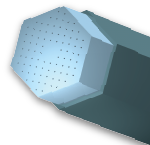 1991: Solid-core photonic-crystal fibers
1991: Solid-core photonic-crystal fibers
Philip Russell, Jonathan Knight and Tim Birks—first at the University of Southampton, and later at the University of Bath—added subwavelength holes to fiber to create a photonic-crystal geometry, creating an artificial low-index cladding to hem light into a higher-index solid core.
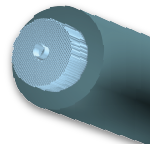 2005: Hollow-core photonic band gap fibers
2005: Hollow-core photonic band gap fibers
The University of Bath group reported a photonic band gap fiber in which a “holey” configuration surrounded a hollow, rather than a solid, core—and which sported an “ultimate low loss” of 1.2 dB/km at 1620 nm wavelengths.
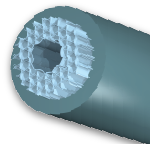 2011: Kagome fibers
2011: Kagome fibers
Bath researchers developed a seven-cell-core, three-ring-cladding cross-section—an example of the “kagome” family of fibers named for a traditional Japanese woven-bamboo pattern—that achieved attenuations of roughly 180 dB/km, over a bandwidth spanning more than 200 THz.
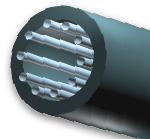 2013-14: Hollow-core antiresonant fibers (HC - ARF)
2013-14: Hollow-core antiresonant fibers (HC - ARF)
Walter Belardi, then at the University of Bath, and Jonathan Knight explored “revolver” designs involving a layer of hollow tubes around the inside of a larger hollow-core fiber.
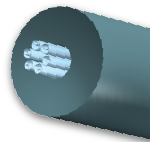 2014 and later: Nested-tube antiresonant fibers
2014 and later: Nested-tube antiresonant fibers
Belardi and, separately, Franesco Poletti at Southampton have demonstrated HC-ARFs that include one smaller tube nested within each larger one. They found in particular that loss could be hammered down by keeping the larger tubes from touching each other and letting light leak out.
[Illustration by Phil Saunders]
Russell realized that adding the subwavelength holes would change the refractive index in the “holey” parts of the fiber, and could create photonic crystals in fibers containing layers of holey and solid silica. He, with OSA Fellows Jonathan Knight and Tim Birks, made the first photonic-crystal fiber by drilling 16-mm holes down the length of 30-mm rods of pure silica, milling them down to hexagonal rods, drawing them into canes, stacking the canes, fusing them together into a preform and drawing them out to form a thin rod. Repeating the stacking, fusing and drawing process three times formed a fiber with arrays of subwavelength holes spaced about 2 µm apart.
The holes reduced the refractive index, allowing the holey region to serve as a low-index cladding around a high-index core if solid silica were placed at the center of the bundle drawn into a fiber. That produced a robust single-mode beam in the solid core. In 1997, after moving to the University of Bath, U.K., the group made an “endlessly single-mode photonic-crystal fiber” that transmitted single mode at wavelengths from 337 to 1550 nm.
Photonic band gap hollow-core fibers
Hollow-core fibers require a different design, because their refractive index is lowest in the core, so total internal reflection would not confine light there. Russell’s group instead confined light by surrounding the central hole with a type of photonic crystal called a photonic band gap, which blocks propagation of photons with certain energies. As with electronic band gaps, which confine the flow of electrons with certain energies in semiconductors, a photonic band gap layer surrounding a hollow core could confine light of the blocked wavelengths so it could not escape from the core.
Fabrication of the first photonic band gap fibers required stacking hundreds of silica capillary tubes and thin rods to make a preform to be drawn into a fiber. Design and optical properties of the Bath group’s early photonic band gap fibers differed considerably. They reported producing full 2D photonic band gaps in the cladding and single-mode confinement in the core after expanding the hole sizes to fill 39% of the cladding volume with air, and leaving a seven-tube void in the center to increase the central hole size by a factor of 20, to 14.8 µm.
Further research reduced fiber loss. Corning Inc., Corning, NY, USA, reported a record-low loss of 13 dB/km at the European Conference on Optical Communications in September 2002, and hopes were high for further reductions for telecommunications. Yoel Fink’s group at the Massachusetts Institute of Technology (MIT), USA, demonstrated a hollow 10-µm waveguide, made by fabricating flat photonic crystal layers and rolling them into a hollow waveguide.
“Hollow-core fibers have massive potential,” Knight wrote in Nature in 2003. Like solid fibers, hollow-core fibers were vulnerable to losses from absorption, Rayleigh scattering, imperfect confinement, bending and structural irregularities. Yet improvements in photonic band gaps were expected to keep light mostly in the hollow core and out of the cladding, reducing absorption and scattering losses and making optical damage and nonlinear effects lower than in conventional solid-core fibers. Hollow cores also looked promising for holding gases for nonlinear optical experiments or for transport of small solid particles.
In a postdeadline paper at OFC 2004, the Bath group and a spinoff company called Blaze Photonics (now part of NKT Photonics) reported a record-low loss of 1.7 dB/km at 1565 nm in hollow-core photonic band gap fibers. The cladding was a hexagonal mesh of thin glass struts—mostly air—surrounding a nearly circular central hole. A later paper claimed an “ultimate low loss” of 1.2 dB/km at 1620 nm in a modified version.
The design seemed a milestone—but it became a plateau. The record-low loss came at the cost of introducing resonances that narrowed the low-loss band to less than 20 nm, with loss peaks of 20 to 30 dB/km on each side. Numerical simulations by Francesco Poletti of the Optoelectronics Research Center at Southampton and colleagues found that photonic band gap fibers had serious problems with mode stability and polarization that could threaten their usefulness for high-capacity data transmission.
Poletti’s group eventually reduced latency and increased usable bandwidth in photonic band gap fibers by minimizing thickness of the glass membranes and the time light spent in glass. In 2013, the team reported a photonic band gap fiber with minimum loss of 3.5 dB/km and a bandwidth of 160 nm that allowed wavelength-division multiplexing (WDM) on 37 channels. Light in the fiber reached 99.7% of its speed in vacuum—fast enough that it would outrace light in a kilometer of solid-core fiber by 1.54 µs. It was notable progress, but it took years to get there.
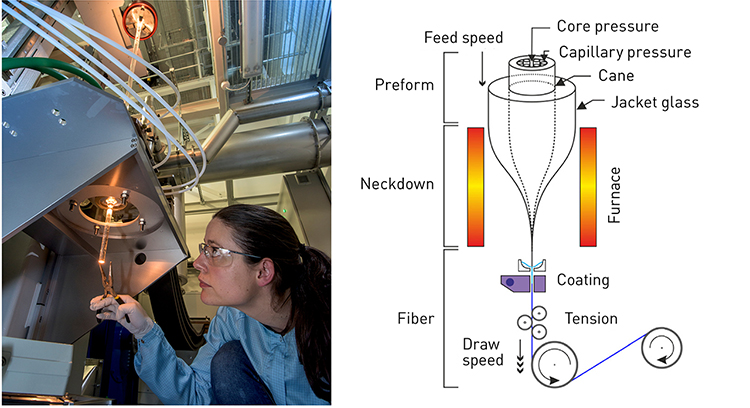 Left: Researcher Natalie Wheeler drawing optical fiber. Right: Creating hollow-core fiber typically involves the drawing of a preform, including capillary tubes and spacing elements stacked within a 20-to-30-mm-diameter tube, into a cane a few mm in diameter. The cane is then packaged in a thicker jacket tube to construct a second preform that is drawn into the final fiber in a fiber drawing tower. During the draw, an inert gas is pumped into the core and capillary regions to control the fiber geometry. [Enlarge image] [University of Southampton / G.T. Jaison et al., Opt. Express 27, 20567 (2019); doi: 10.1364/OE.27.020567]
Left: Researcher Natalie Wheeler drawing optical fiber. Right: Creating hollow-core fiber typically involves the drawing of a preform, including capillary tubes and spacing elements stacked within a 20-to-30-mm-diameter tube, into a cane a few mm in diameter. The cane is then packaged in a thicker jacket tube to construct a second preform that is drawn into the final fiber in a fiber drawing tower. During the draw, an inert gas is pumped into the core and capillary regions to control the fiber geometry. [Enlarge image] [University of Southampton / G.T. Jaison et al., Opt. Express 27, 20567 (2019); doi: 10.1364/OE.27.020567]
Research groups worldwide have tested some 50 different ways of confining light in hollow-core fibers in the past twenty years.
Hollow-core antiresonant fibers
Groups worldwide have tested some 50 different ways of confining light in hollow-core fibers in the past 20 years, says Poletti. A key lesson has been that light in the low-index hole tends to leak into the surrounding higher-index materials, which have higher attenuation. Research also has shown that most losses decrease as the size of the hollow core increases, but that increasing the core size also raises bend loss. That’s a potentially serious problem; indeed, it was a fatal one for millimeter waveguides transmitting in the 50-GHz range that were tried out for long-distance telephony in the 1960s.
Theorists in the 1990s had predicted that an antiresonant layer between a hollow core and the surrounding cladding could confine light by reflecting it back into the core. Support for that idea came from experiments with a structure originally thought to guide light in a hollow core by creating photonic band gaps: hexagonal lattices of thin glass, called kagome after a traditional Japanese pattern for woven bamboo.
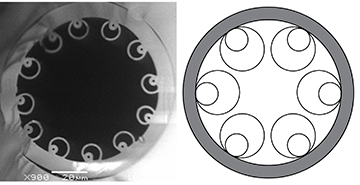 Cross-sections of early hollow-core fibers, fabricated by Walter Belardi of the University of Bath U.K., and later the University of Lille, France, involving nested hollow tubes, in which the tubes did not touch each other. The fibers’ transmission properties depend on the number of rings around the edge of the hollow core, their diameters and their spacing. [W. Belardi, J. Lightwave Technol. 33, 4497 (2015)]
Cross-sections of early hollow-core fibers, fabricated by Walter Belardi of the University of Bath U.K., and later the University of Lille, France, involving nested hollow tubes, in which the tubes did not touch each other. The fibers’ transmission properties depend on the number of rings around the edge of the hollow core, their diameters and their spacing. [W. Belardi, J. Lightwave Technol. 33, 4497 (2015)]
In 2007, a group at Bath experimenting in guiding multi-octave frequency combs found that the light-guiding depended not on reflection back into the core, but on prevention of light coupling between core and cladding modes. YingYing Wang and others then at Bath subsequently tested a kagome fiber with ice-cream-cone-shaped hypocycloid curves facing into the hollow core. The team found that negatively curved surfaces facing the core created an antiresonance that damped down coupling of light from the hollow core into the cladding.
This demonstration of antiresonance guiding in a hypocycloid kagome fiber was an important early step toward a new class of fibers called hollow-core antiresonant fibers (HC-ARF). The next one came in 2013 and 2014, when Walter Belardi, then at Bath and now at the University of Lille in France, showed numerically that negative curvature improved light confinement inside the hollow core. He created the negative curvature by fabricating a single layer of hollow tubes that run along the inside of a hollow tube. Then he developed the crucial new concept of the nested ring design, which added a second smaller hollow tube inside each tube in the negative-curvature layer. Doing that, as well as keeping the parallel tubes from touching, reduced light coupling from the core into the cladding, and thus reduced fiber attenuation.
A major difference between antiresonant and photonic band gap fibers lies in their confinement structures. Photonic band gap fibers have many layers of thin-walled holey lattices of glass in their inner cladding, which create the photonic band gap effect that blocks a range of wavelengths, with the innermost cells just outside the core–cladding boundary. The tubes that form the antiresonant layer are just inside the core–cladding boundary, and the surrounding cladding is solid. The antiresonant structure is smaller than the photonic band gap—typically six or eight dual tubes—and actually affords more degrees of freedom to adjust fiber properties. The photonic band gap layer is thicker and contains many more tubes.
Drawing attention: NANFs
Later in 2014, Poletti built on that work to propose a hollow-core fiber design he called a nested antiresonant nodeless hollow-core fiber (NANF). His analysis indicated that the attenuation in NANF fibers due to leakage, surface scattering and bending could be lower than for conventional solid fibers. Removing the nodes where tubes touched could give the NANF fiber a low-loss antiresonant band an octave wide, and suppress high-order modes well enough to make the fiber effectively single mode for a distance adequate for communication. Physical experiments confirmed the promise of the design. In 2017, a team at the University of Limoges, France, reported transmission loss of 7.7 dB/km at 750 nm—only a factor of two above Rayleigh scattering at that band—in a hollow-core fiber with a single nodeless ring of tubes. Another fiber, optimized for spectral bandwidth, had transmission of 10–20 dB/km across a wavelength band of more than one octave.
Results improved steadily. At the ECOC 2018 postdeadline session, Thomas Bradley of Southampton reported minimum loss of only 1.3 dB/km at 1450 nm in a nodeless nested NANF fiber—the first hollow-core fiber to beat the 1.7 dB/km for a photonic band gap fiber at OFC 2004. The 0.5-km NANF fiber was effectively single mode, and had loss below 1.5 dB/km across a respectable spectral range of 65 nm.
Bradley reported another record at ECOC 2019, with minimum loss of 0.65 dB/km across the full erbium-fiber amplifier band—half the loss of the fiber he had described only a year before, a performance reportedly attributable to improvements in tube handling, preform fabrication and pressurization, which improved uniformity along the fiber length as well as cross-sectional symmetry. Simulations suggested that the loss included 0.31 dB/km of light leakage and 0.24 dB/km of microbending, which might be eliminated—leaving a fundamental loss of only 0.1 dB/km from surface scattering that could not be reduced.
Continuing refinements in the design and fabrication of hollow-core NANF fibers more than halved attenuation, Eric Numkam Fokoua of Southampton reported in a postdeadline paper at the 2020 OFC. Loss was 0.28 dB/km between 1510 and 1600 nm, and close to 0.3 dB/km between 1500 and 1640 nm for a 2.8-km fiber. And, in an interesting twist, a November 2020 paper from the group introduced NANF fibers with attenuation lower than Rayleigh scattering in silica fibers at some wavelengths between 600 and 1100 nm. That’s outside of the band currently important for communications, but could be important for applications such as delivering laser power and low-loss transmission of qubits in some quantum systems.
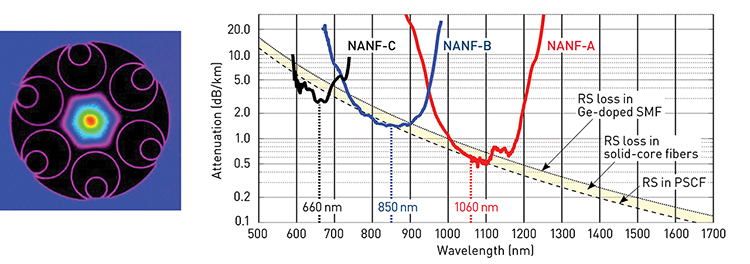 In a November 2020 paper, researchers from the University of Southampton, U.K., reported nested antiresonant nodeless fibers (NANFs) that, confining the transmitted optical mode in a hollow core between six nested tubes, achieved loss comparable to the Rayleigh-scattering limit in silica fibers at three optical wavelengths. [Enlarge image] [H. Sakr et al., Nat. Commun. 11, 6030 (2020); CC BY 4.0]
In a November 2020 paper, researchers from the University of Southampton, U.K., reported nested antiresonant nodeless fibers (NANFs) that, confining the transmitted optical mode in a hollow core between six nested tubes, achieved loss comparable to the Rayleigh-scattering limit in silica fibers at three optical wavelengths. [Enlarge image] [H. Sakr et al., Nat. Commun. 11, 6030 (2020); CC BY 4.0]
Niche applications
At least for now, the NANF design has a clear lead among hollow-core fibers for communications. The lowest reported loss is only a factor of two above that in solid-core fibers, and Poletti says the remaining losses appear to be more practical than fundamental. Southampton is focusing on minimizing single-mode loss for long-haul communications, with their design tuned to let higher-order modes escape, leaving only the lowest-order mode in the hollow core.
The rapid progress in reducing fiber loss over the past few years has been impressive and encouraging. A factor-of-two decrease is huge compared with conventional solid-core fibers, where, after half a century, attenuation has been pushed very close to fundamental limits. So far, the NANF design has not run into the performance tradeoffs that limited photonic band gap fibers.
The application spotlight has focused on telecommunications, which is a big and fast-growing market. However, telecommunications also is a big business. And there, according to Sergejs Makovejs, market and technology development manager at Corning Optical Fiber and Cable, what matters is whether “hollow-core fiber could provide lower cost per bit compared to conventional silica fibers.”
The low latency and low nonlinearity of hollow-core fibers could be compelling for high-frequency securities trading, low-latency 5G services or transmitting at high optical powers.
Decades of mass production have brought conventional step-index single-mode fibers to prices that will be hard to match for ordinary applications. However, the low latency and low nonlinearity of hollow-core fibers could be compelling for high-frequency securities trading, low-latency 5G services or transmitting at high optical powers. Hollow-core fibers also are in the running for niche applications such as fiber sensors and high-nonlinearity optical devices including lasers.
A handful of companies make hollow fibers for special applications, including OFS Optics, a subsidiary of Furukawa; NKT Photonics, which has made photonic-crystal fibers for nearly two decades; and Lumenisity, a spin-out of the Optoelectronic Research Center at Southampton founded by Poletti and two other professors in Romsey, U.K. Corning is investigating prospects but has yet to see a compelling potential market.
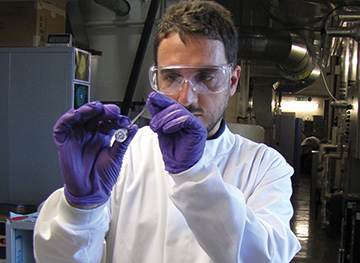 Francesco Poletti, Optoelectronics Research Centre, University of Southampton, U.K. [University of Southampton]
Francesco Poletti, Optoelectronics Research Centre, University of Southampton, U.K. [University of Southampton]
Cabling and sensors
Another sure sign of commercial interest in hollow-core fibers is the development of cables specifically for them. At OFC 2020, Benyuan Zhu of OFS Laboratories, Somerset, NJ, USA, described what he called “the first field-deployable hollow-core fiber cable.” The target market is for high-frequency computerized security trading, where the benefits of shaving 1.45 microseconds per kilometer from the time of delivering orders to the trading floor could justify paying a healthy premium for a faster hollow-core fiber cable.
Another potential application for hollow-core fibers is in sensors, particularly for fiber ring-resonator gyroscopes for rotation sensing, an idea that dates back to 2006. Fiber gyros need single-mode fiber, and OFS demonstrated suppression of high-order modes in a hollow-core fiber for gyroscopes in 2014. They have demonstrated a bend radius down to five centimeters without significant loss or multimoding, important for gyro applications.
Other opportunities are in the offing for hollow-core fibers. Air and vacuum have much lower thresholds for nonlinear effects and damage than solids, making them attractive for delivering high-power laser pulses as well as continuous beams. Many people are using them for high powers that would damage any solid fiber. If the hollow core is made tiny, it can be filled with gas for nonlinear devices. Hollow-core fibers that keep most light out of the glass can transmit wavelengths where silica is highly absorbing or opaque. Backscattering “is so low that you don’t see anything but the noise floor with standard measuring equipment,” says Poletti.
The list goes on. OSA Fellow David DiGiovanni sees a wealth of opportunities, but notes that the firm is proceeding carefully. “Like a kid in a candy store, we want them all,” he says. But as chief technology officer at OFS, he knows they can’t do everything.
Jeff Hecht is an OSA Fellow and freelance writer who covers science and technology.
For references and resources, go online: www.osa-opn.org/link/hollow-core_fiber
